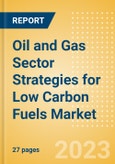Amid increasing pressure to decarbonize and diversify its products, this report outlines oil and gas sector strategies within the low carbon fuels market. The report identifies renewable diesel, sustainable aviation fuels (SAFs), and synthetic fuel as key focus areas based on existing oil and gas infrastructure as well as workforce skills and expertise. The report assesses the production outlook for each of these low carbon fuels and indicates the biggest areas of opportunity for oil and gas players.
Key Highlights
- Larger production capacities of renewable fuels are typically being achieved by renewable standalone projects, where construction is not hampered by an existing refinery footprint. Although these projects require a much higher capital expenditure.
- Based on the publisher's database of active and upcoming renewable refinery projects, renewable diesel production is expected to exceed 8,900 mmgy by 2030.
- Only 4 of the top 10 integrated oil and gas companies by market capitalization feature in our renewable diesel ranking by capacity.
- Taking together both active and pipeline production capacity, SAF production is expected to exceed 6,100 mmgy in 2030.
- Low synthetic fuel production is partly due to the early stages of this technology and the challenges of achieving economically viable production on a commercial scale.
Scope
- Renewable diesel production outlook
- Renewable diesel upcoming projects
- SAFs production outlook
- SAFS upcoming projects
- Synthetic fuels production outlook
- Low carbon fuel deal activity within oil and gas
- Company filing trends within low carbon fuels
Reasons to Buy
- Obtain the most up to date information on recent developments and policies related to oil and gas sector strategies in the low carbon fuels segment.
- Identify the opportunities of challenges associated with the switch form oil refining to renewable refineries for crude oil refiners.
- Gain insight into the production outlook for renewable diesel, SAFS, and synthetic fuels.
- Assess competitors based on their active and pipeline capacities for low carbon fuel production and gain an overview of largest upcoming renewable refinery projects.
Table of Contents
- Executive Summary
- Oil and Gas Sector Strategies for Low Carbon Fuels
- Oil and gas sector challenges
- Oil and gas focus areas in the low carbon fuels market
- Introduction to our focus low carbon fuels
- Sector strategies for transitioning to renewable fuels
- Converted/ coprocessing refineries vs standalone projects
- Renewable Diesel
- Renewable diesel production outlook
- Current market leaders in renewable diesel
- The largest renewable diesel projects by 2030 capacity
- Company filing trends in oil and gas
- Consumption and deal trends
- Sustainable Aviation Fuel
- SAF production outlook
- The largest SAF projects by 2030 capacity
- Current and projected market leaders in SAFs
- Company filing trends in oil and gas
- Deal activity
- Synthetic Fuels
- Production outlook
- Oil and gas synthetic fuel players
- Contact the Publisher
- Largest renewable diesel projects by their 2030 capacity
- Largest SAF projects by their 2030 capacity
- Key Takeaways
- Oil and gas sector challenges
- Oil and gas focus areas in the low carbon fuels market
- Introducing the three focus low carbon fuels for the oil and gas sector
- Types of renewable refinery
- Renewable refineries by type and project count, 2023 - 2030
- CAPEX across renewable refinery types
- Renewable diesel production outlook, 2018 - 2030
- Top 15 renewable diesel companies by capacity in 2022
- Mentions of renewable diesel in oil and gas company filings, 2016 - August 2023
- Top oil and gas players by mentions of renewable diesel within company filings
- Renewable diesel consumption, 2022 - 2040
- Oil and gas deals related to renewable diesel 2018 - 2022
- SAF production outlook, 2018 - 2030
- Top SAF producers by 2022 capacity
- Top SAF producers by 2030 capacity
- SAF mentions by oil and gas companies, 2018 - 2023 (YTD)
- Top oil and gas players by mentions of SAFs in company filings between 2018 and 2023 (YTD)
- A snapshot of SAF deal activity in the oil and gas sector
- Synthetic fuel production and project count, 2018 - 2030
- Upcoming synthetic fuel production capacity of oil and gas players as of August 2023
Companies Mentioned (Partial List)
A selection of companies mentioned in this report includes, but is not limited to:
- Diamond Green diesel
- Neste Corp
- Diamond Green Diesel LLC
- Eni SpA
- Marathon Petroleum Corp
- Phillips 66
- TotalEnergies SE
- Preem AB
- BP Plc
- HF Sinclair Corp
- Renewable Energy Group
- Repsol SA
- PT Pertamina
- The Hong Kong and China Gas Company Ltd
- Darling Ingredients Inc
- Valero Energy Group
- Chevron Corp
- PBF Energy Inc
- Exxon Mobil Corp
- Beijing Haixin Energy Technology Co Ltd
- Mubadala Investment Co
- CVR Energy
- Global Clean Energy Holdings Inc
- Tidewater Renewables Ltd
- Vertex Energy Inc
- Aemetis Inc
- UPM-Kymmene Corp
- EcoCeres Inc
- Gevo Inc
- Alfanar Gorup
- Oriental Energy Co Ltd
- Azure Sustainable Fuels Corp
- World Energy LLC
- Summit Agricultural Group
- DG Fuels LLC
- Indaba Renewable Fuels California LLC
- China Petrochemical Corp
- Calumet Specialty Product Partners LP
- Energy Absolute Public Co Ltd
- Fulcrum Bioenergy Inc
- Air BP Ltd
- Sasol Ltd
- Velocys Plc
- Suncor Energy Inc
- Praj Industries Ltd
- Gulf Oil International
- Air Products and Chemicals Inc








